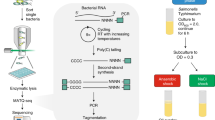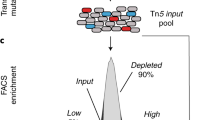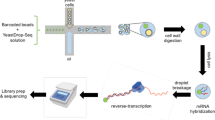Abstract
Characterizing and understanding the functional heterogeneity in a given population on the cellular and molecular level is a great challenge in microbiology. Each microorganism contributes differently to the overall performance of the community and responds differently to changing microenvironmental conditions. Here, we present a method for isolation of intact RNA out of small subpopulations of live Saccharomyces cerevisiae cells for differential gene expression analysis. The protocol includes fluorescence staining, flow cytometric analysis and sorting of live yeast cells, subsequent isolation of RNA from the resulting subpopulations and finally RNA quantification and integrity check. The isolated RNA can be transcribed into cDNA and successfully used for microarray analysis. This aids in relating molecular regulation processes within subpopulations with the dynamics and functioning of the entire population. The procedure can be accomplished in 2 d.
This is a preview of subscription content, access via your institution
Access options
Subscribe to this journal
Receive 12 print issues and online access
$259.00 per year
only $21.58 per issue
Buy this article
- Purchase on Springer Link
- Instant access to full article PDF
Prices may be subject to local taxes which are calculated during checkout







Similar content being viewed by others
Accession codes
References
Kleinsteuber, S., Riis, V., Fetzer, I., Harms, H. & Müller, S. Population dynamics of a microbial consortium during growth on diesel fuel in saline environments. Appl. Environ. Microbiol. 72, 3531–3542 (2006).
Shi, L. et al. Limits of propidium iodide (PI) as a cell viability indicator for environmental bacteria. Cytometry A 71, 592–598 (2007).
Becker, T. et al. Future aspects of bioprocess monitoring. Adv. Biochem. Eng./Biotechnol. 105, 249–293 (2007).
Han, J. & Lillard, S.J. In-situ sampling and separation of RNA from individual mammalian cells. Anal. Chem. 72, 4073–4093 (2000).
Juan, G., Hernando, E. & Cordon-Cardo, C. Separation of live cells in different phases of the cell cycle for gene expression analysis. Cytometry 49, 170–175 (2002).
Bryant, Z. et al. Characterization of differentially expressed genes in purified Drosophila follicle cells: toward a general strategy for cell type-specific developmental analysis. Proc. Natl. Acad. Sci. USA 96, 5559–5564 (1999).
Coombs, J., Darley, W.M., Holm-Hansen, O. & Volcani, B.E. Studies on the biochemistry and fine structure of silica shell formation in diatoms. Chemical composition of Navicula pelliculosa during silicon-starvation synchrony. Plant Physiol. 42, 1601–1606 (1967).
Pessot, C.A. et al. Presence of RNA in the sperm nucleolus. Biochem. Biophys. Res. Commun. 158, 272–278 (1989).
Bremer, H. & Dennis, P.P. Modulation of chemical composition and other parameters of the cell by growth rate. in Escherichia coli and Salmonella: Cellular and Molecular Biology (Ed. in Chief Neidhardt, F.C.) 1555–1569 (ASM Press, Washington, DC, 1996).
Mutiu, A.I. & Brandl, C.J. RNA isolation from yeast using silica matrices. J. Biomol. Tech. 16, 316–317 (2005).
Ertugay, N. & Hamamci, H. Continuous cultivation of bakers' yeast: change in cell composition at different dilution rates and effect of heat stress on trehalose level. Folia Microbiol. (Praha) 42, 463–467 (1997).
Nissen, T., Schulze, U., Nielsen, J. & Villadse, J. Flux distributions in anaerobic, glucose-limited continuous cultures of Saccharomyces cerevisiae. Microbiology 143, 203–218 (1997).
Sebastian, J., Mian, F. & Halvorson, H.O. Effect of the growth rate on the level of the DNA-dependent RNA polymerases in Saccharomyces cerevisiae. FEBS Lett. 34, 159–162 (1973).
Gorokhova, E. Effects of preservation and storage of microcrustaceans in RNAlater on RNA and DNA degradation. Limnol. Oceanogr. Methods 3, 143–148 (2005).
Chirgwin, J.M., Przybyla, A.E., MacDonald, R.J. & Rutter, W.J. Isolation of biologically active ribonucleic acid from sources enriched in ribonuclease. Biochemistry 18, 5294–5299 (1979).
Schmitt, M.E., Brown, T.A. & Trumpower, B.L. A rapid and simple method for preparation of RNA from Saccharomyces cerevisiae. Nucleic Acids Res. 18, 3091–3092 (1990).
Kohrer, K. & Domdey, H. Preparation of high molecular weight RNA. Methods Enzymol. 194, 398–405 (1991).
McEntee, C.M. & Hudson, A.P. Preparation of RNA from unspheroplasted yeast cells (Saccharomyces cerevisiae). Anal. Biochem. 176, 303–306 (1989).
Chomczynski, P. & Sacchi, N. Single-step method of RNA isolation by acid guanidinium thiocyanate–phenol–chloroform extraction. Anal. Biochem. 162, 156–159 (1987).
Felipe, M.S.S., Rogelin, R., Azevedo, M.O. & Astolfi-Filho, S. Extended application of an efficient method for RNA isolation from different organisms. Biotechnol. Tech. 7, 639–644 (1993).
Fox et al. A gene expression fingerprint of C. elegans embryonic motor neurons. BMC Genomics 6, 42 (2005).
Achilles, J., Müller, S., Bley, T. & Babel, W. Affinity of single S. cerevisiae cells to 2-NBDglucose under changing substrate concentrations. Cytometry A 61A, 88–98 (2004).
Achilles, J., Harms, H. & Müller, S. Analysis of living S. cerevisiae cell states—a three colour approach. Cytometry A 69A, 173–177 (2006).
Kurimoto, K. et al. An improved single-cell cDNA amplification method for efficient high-density oligonucleotide microarray analysis. Nucleic Acids Res. 34, e42 (2006).
Kurimoto, K., Yabuta, Y., Ohinata, Y. & Saitou, M. Global single-cell cDNA amplification to provide a template for representative high-density oligonucleotide microarray analysis. Nat. Protoc. 2, 739–752 (2007).
Schatzmann, H. Anaerobes Wachstum von Saccharomyces cerevisiae. Regulatorische Aspekte des glycolytischen und respirativen Stoffwechsels PhD thesis, no. 5504 (ETH, Zürich, 1975).
Diez, C., Bertsch, G. & Simm, A. Isolation of full-size mRNA from cells sorted by flow cytometry. J. Biochem. Biophys. Methods 40, 69–80 (1999).
Esser, C., Göttlinger, C., Kremer, J., Hundeiker, C. & Radbruch, A. Isolation of full-size mRNA from ethanol-fixed cells after cellular immunofluorescence staining and fluorescence-activated cell sorting (FACS). Cytometry 21, 282–386 (1995).
Klis, F.M., Mol, P., Hellingwerf, K. & Brul, S. Dynamics of cell wall structure in Saccharomyces cerevisiae. FEMS Microbiol. Rev. 26, 239–256 (2002).
Kretschmer, M., Schellenberger, W., Otto, A., Kessler, R. & Hofmann, E. Fructose-2,6-bisphosphatase and 6-phosphofructo-2-kinase are separable in yeast. Biochem. J. 246, 755–759 (1987).
Acknowledgements
We thank H. Engewald and C. Süring for technical assistance. We thank T. Hübschmann for technical assistance as well as for helpful discussions and A. Pernthaler for critical reading of the manuscript. We also thank C. Repenning and M. Pähler from the working group 'Chip Technology' at the Institute of Technical Chemistry of the University of Hannover. This work was supported by the Deutsche Forschungsgemeinschaft (MU 1089/5-3).
Author information
Authors and Affiliations
Corresponding author
Ethics declarations
Competing interests
The authors declare no competing financial interests.
Rights and permissions
About this article
Cite this article
Achilles, J., Stahl, F., Harms, H. et al. Isolation of intact RNA from cytometrically sorted Saccharomyces cerevisiae for the analysis of intrapopulation diversity of gene expression. Nat Protoc 2, 2203–2211 (2007). https://doi.org/10.1038/nprot.2007.322
Published:
Issue Date:
DOI: https://doi.org/10.1038/nprot.2007.322
This article is cited by
-
Technical pipeline for screening microbial communities as a function of substrate specificity through fluorescent labelling
Communications Biology (2022)
-
Cytometry meets next-generation sequencing – RNA-Seq of sorted subpopulations reveals regional replication and iron-triggered prophage induction in Corynebacterium glutamicum
Scientific Reports (2018)
Comments
By submitting a comment you agree to abide by our Terms and Community Guidelines. If you find something abusive or that does not comply with our terms or guidelines please flag it as inappropriate.



